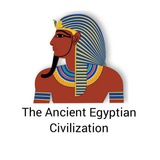Ballana and Qustul.Ballana is located on the west bank of the Nile opposite to Qustul, 300 km south of Aswan. The excavations conducted at the site between 1928 and 1931 revealed one of the cemeteries of Lower Nubia known as the Ballana and Qustul Culture or the X-Group. The tombs may have belonged to several kings, queens, and nobles of “Nobatia”, one of the Nubian kingdoms that flourished after the fall of the Kingdom of Meroe, but before the rise of the Christian kingdoms of Nubia between 350 and 600 AD. The tombs were distinguished by their pure Nubian origins and contents, in addition to many objects that were imported from Byzantine Egypt or the Mediterranean which indicated their relation with the Byzantine world before the spread of Christianity.A crown made of silver and precious stones, probably for one of the kings of the Kingdom of "Nobatia".displayed in the National Museum of Egyptian Civilization in Cairo, Egypt.
#NMEC
#NMEC
The Ancient Egyptians excelled in the art of architecture since the beginning of the civilization. Different forms of architecture emerged according to the need, religious, civil and military architecture, and till this day the Great Pyramid is evidence of the ingenuity and precision of the Egyptians in building and construction.The skill of the Egyptians in architecture led to the invention of construction equipment and tools that are still used today, such as sledge to pull huge stones, and measuring tools such as the cubit, angle, and horizontal and vertical plumb to adjust the locations and angles of building points with high accuracy.Construction tools from the Tomb of Sennedjem, tomb No. 1 in Deir El-Madina, dating back to the Nineteenth Dynasty (1295: 1186 BC) of the New Kingdom.Displayed in The National Museum of Egyptian Civilization in Cairo, Egypt.
#NMEC
#NMEC
An ostracon depicting a scene of a concert and a banquet for some nobles. This scene was on the walls of one of the tombs in western Thebes.Limestone, Deir el-Bahari, New Kingdom.Displayed in the National Museum of Egyptian Civilization in Cairo, Egypt.
#NMEC
#NMEC
The National Museum of Egyptian Civilization held a concert in celebration of its two-year opening anniversary, and in conjunction with International Music Day.The concert was held at the outer area overlooking the Ain al-Hayat Lake, as part of the activities of "Eternal Egypt" in partnership with RMC, which was launched by the museum in the framework of organizing several artistic and cultural concerts.
#NMEC
#NMEC
Niobe the daughter of Tantalus, king of Phrygia in Asia Minor, and wife of Amphion who founded the Greek city of Thebes and built its walls. The Greeks considered her a patroness of education and knowledge, and a goddess of Thebes. Niobe and Amphion had seven sons and seven daughters, all of them were of beauty and splendor, and Niobe always bragged about them, which provoked the jealousy and anger of the goddess Leto, the wife of Zeus, who only gave birth to Apollo and Artemis. Which lead Leto to plan a revenge on Niobe, where Apollo killed the boys and Artemis killed the girls; Niobe wept for the loss of her children, until she turned to rock over the Mount Sipylus.
Marble, 2nd century AD, loxur.Displayed in the National Museum of Egyptian Civilization in Fustat, Cairo.
#NMEC
Marble, 2nd century AD, loxur.Displayed in the National Museum of Egyptian Civilization in Fustat, Cairo.
#NMEC
The purification tent of princess Isetemkheb II, Deir el Bahri Cache 1881, ca. 1046 – 1037 BC. Displayed in the National Museum of Egyptian Civilization in Cairo, Egypt.
#NMEC
#NMEC
The Holy Ka'aba Key Bag. Green silk embroidered with serma, Ottoman period, reign of Sultan Al-Ghazi Abdul Majid Khan (1839-1861AD). Displayed in the National Museum of Egyptian Civilization in Cairo, Egypt.
#NMEC
#NMEC
Tanagra figurines are among the most famous artifacts of the Greek era since the seventh century B.C, and got their name from the Greek city of Tanagra. The figurines were made of burnt clay, and they usually depicted women wearing gowns with folds, or scenes of workers and young children and were placed in homes as they were and as offerings to be placed next to the deceased. Alexandria and Naukratis are among the most important centers of Tanagra production in Egypt, showing aspects of life and of the fashion in Egypt during the Greco-Roman era Ptolemaic period (305-30 BC). Displayed in the National Museum of Egyptian Civilization in Cairo, Egypt.
#NMEC
#NMEC
The priest Psmatik Seneb holding naos of the god Atum, Tanis, (ca. 747 - 332 B. C). Displayed in the National Museum of Egyptian Civilization in Cairo, Egypt.
#NMEC
#NMEC
This multi-story building model depicts a Purgos house, a style of multi-story dwellings that was common in the Greco-Roman era, and this three-story model was a gift to a temple, perhaps to seek protection for the house. It appears in it the way of building the mud brick coruses in a wavy way to support and stabilize the building.
The Roman era (30 BC - 395 AD), Sakha - Kafr El-Sheikh, limestone. Displayed in the National Museum of Egyptian Civilization in Cairo, Egypt.
#NMEC
The Roman era (30 BC - 395 AD), Sakha - Kafr El-Sheikh, limestone. Displayed in the National Museum of Egyptian Civilization in Cairo, Egypt.
#NMEC
